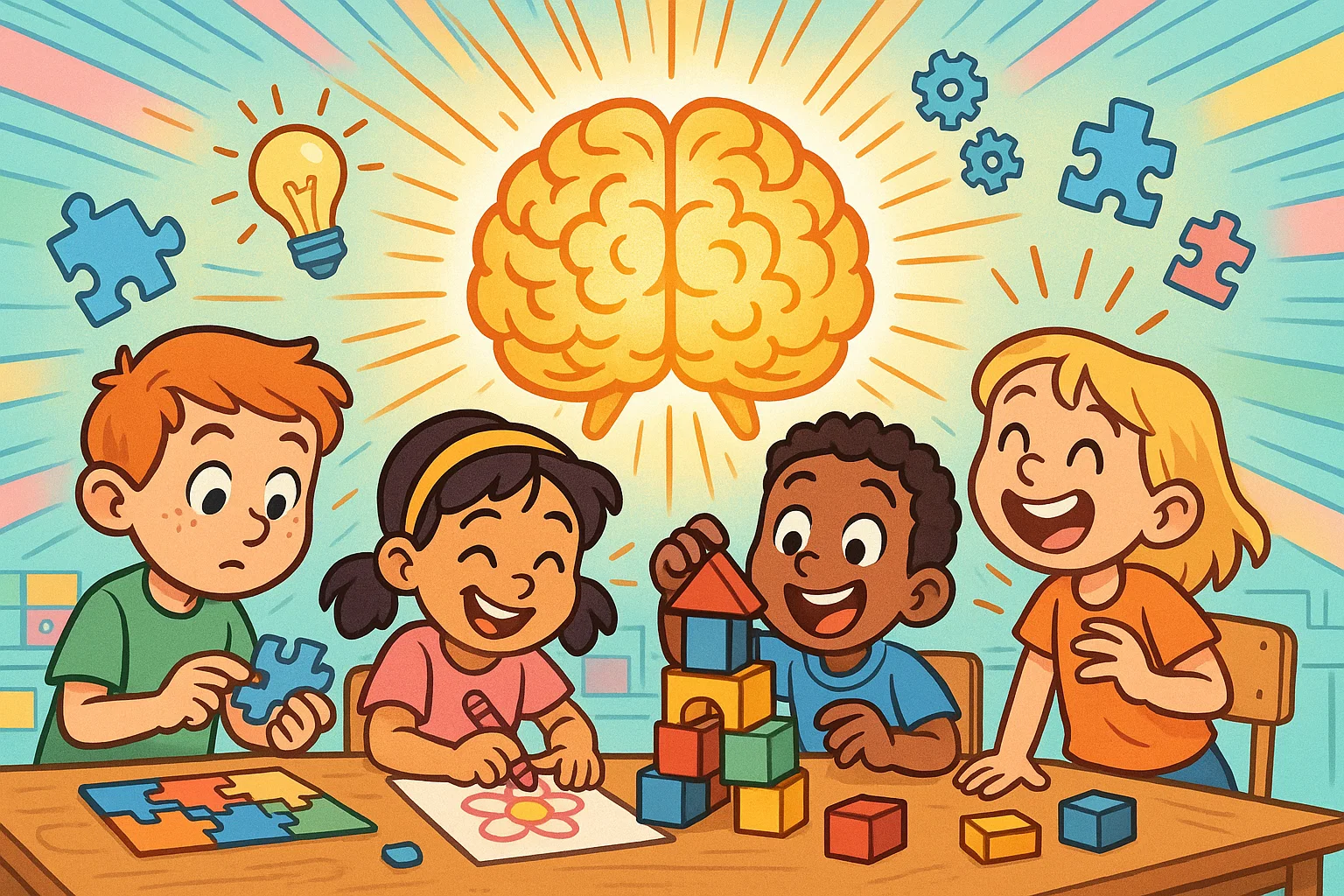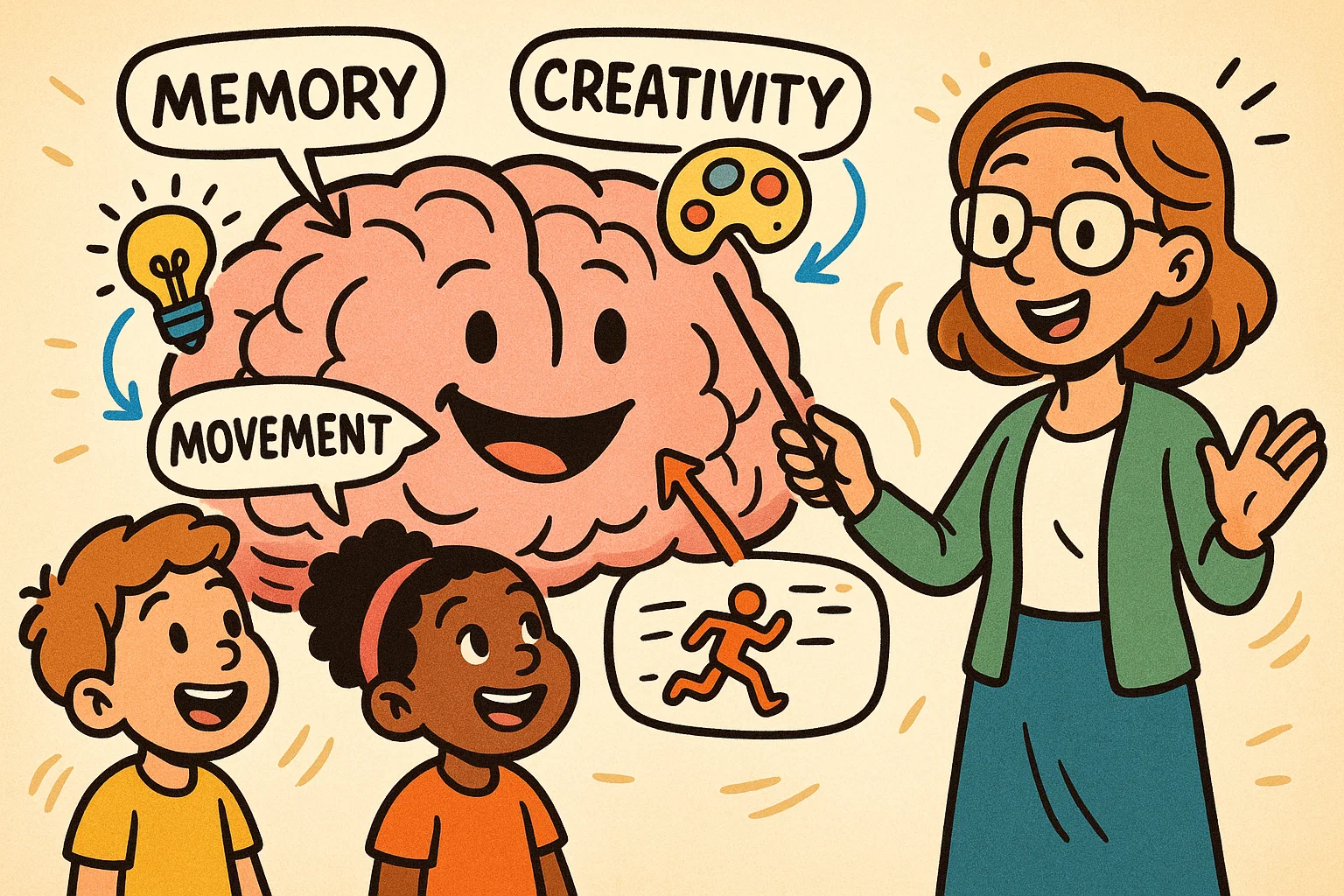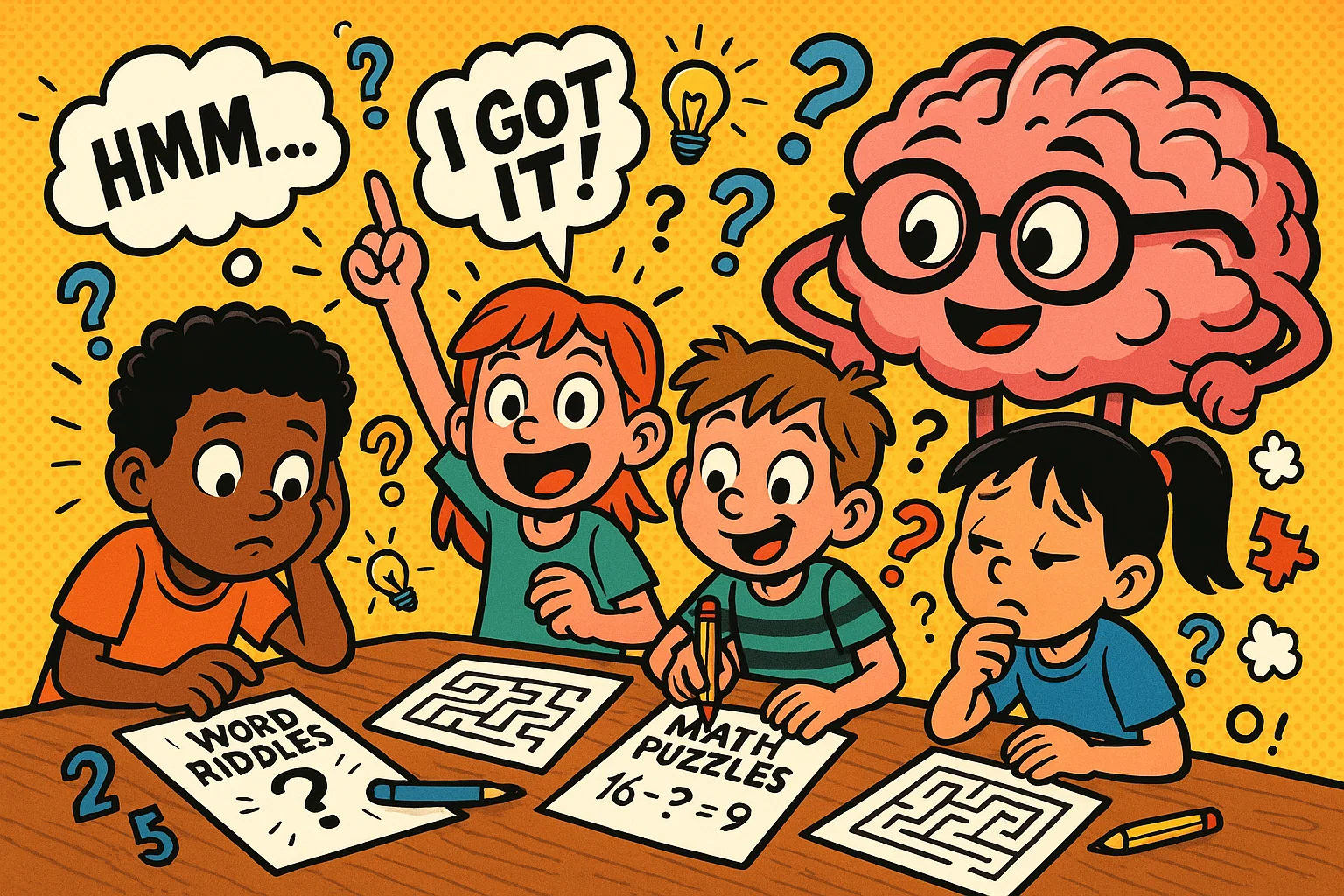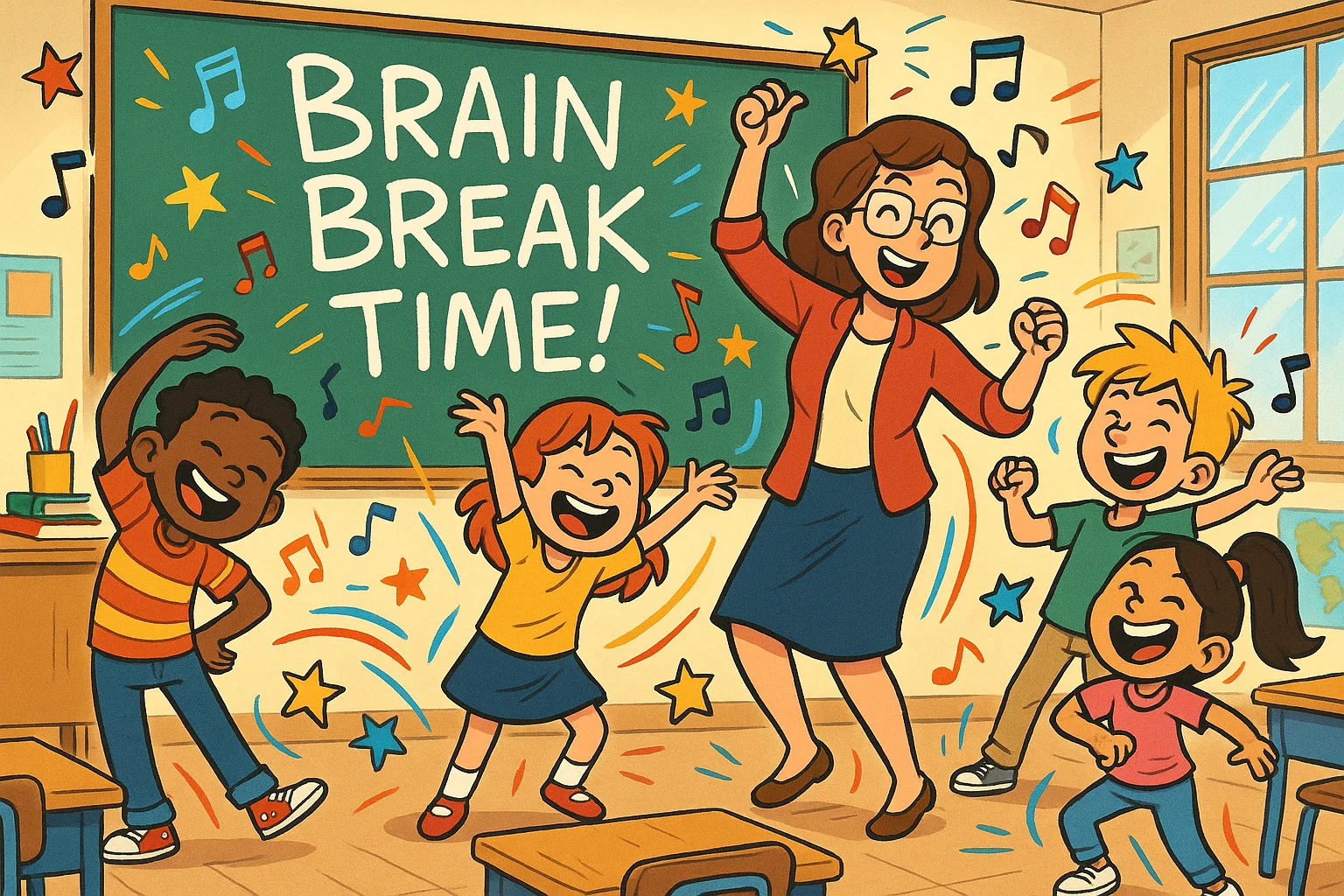Brain Activity for Kids — Fun Exercises, Games and Ideas to Boost Learning

Developing a child’s amazing brain isn’t just about preparing them for school; it’s about nurturing their creativity, emotional resilience, and lifelong capacity for learning. Cognitive skills, like focus, memory games, and problem-solving, are the foundation upon which all future success is built. These foundational skills are not fixed—they grow strongest through consistent mental exercise.
A great way to give your child’s brain the stimulation it needs is through playful interaction. Engaging in fun brain activities and games for kids doesn’t feel like work; it feels like an adventure. When children explore, experiment, and challenge their minds in a low-stress environment, they strengthen their neural pathways, making learning easier and more enjoyable. This guide will provide you with practical, brain-boosting exercises perfect for home or the classroom.
Brain Function Basics for Kids

Think of your child’s brain as a sophisticated control center that never sleeps! It’s responsible for everything they do: how they think, remember, move, and feel. The brain works by sending and receiving signals incredibly fast. When teaching kids about their brain, it’s helpful to simplify its complex jobs. Every time your child solves a puzzle or learns a new word, their brain gets stronger!
Key Parts of Brain and Their Roles
The brain is divided into specialized parts that work together like a skilled team.
| Brain Part | Primary Role | Everyday Example |
| Frontal Lobe (The “Boss”) | Critical thinking skills, planning, self-control, and decision-making. | Choosing which Lego piece to use next or stopping before touching a hot stove. |
| Cerebellum (The “Coach”) | Coordinates movement, balance, and fine motor skills. | Riding a bike, walking, or perfecting hand-eye coordination for drawing. |
| Temporal Lobe (The “Archivist”) | Processes sound and helps with memory and language comprehension. | Remembering the words to a song or understanding a story being read aloud. |
| Occipital Lobe (The “Visionary”) | Interprets visual information. | Seeing colors, reading a book, or finding a hidden object in an “I spy” game. |
How Neurons Communicate
The fundamental units of the brain are neurons, often called brain messengers. Imagine them as a massive network of tiny electric wires or a team of players passing a ball. When a child learns a new skill, like tying their shoe or solving a riddle, the neurons relevant to that skill fire together. This repeated firing creates strong connections—or superhighways—between the neurons, making it faster and easier for the brain to recall that skill next time. This process is how the brain learns and strengthens.
Fun Facts About the Brain
Here are some surprising facts to help get kids excited about their amazing brain:
- Your brain uses about 20% of your body’s oxygen and calories, even though it’s only about 2% of your body weight. That’s why a healthy diet is so important!
- The brain generates about 12-25 watts of power—enough to light a low-wattage LED bulb! This energy is used for constant activity, even when you’re sleeping.
- Your brain is about 75% water. Keeping hydrated helps your brain function better and stay attentive.
- The human brain has approximately 86 billion neurons. That’s more than the number of stars in the Milky Way galaxy!
Brain Development Activities for Kids
To truly boost a child’s cognitive abilities, activities must be engaging and varied. The following activities for kids focus on stimulating different parts of the brain through creative play, logic challenges, and movement.
Creative Thinking Games
Creative play is a fantastic, screen-free way to stimulate the prefrontal cortex—the part of the brain responsible for innovation and flexible thinking.
- Imaginary World Building: Ask your child to describe an imaginary land, complete with its own rules, animals, and cities. This enhances narrative skills and encourages them to visualize.
- Invent-a-Tool: Take a common household object (like a spoon or a sock) and challenge your child to list 10 new, completely different uses for it. This simple activity nurtures lateral thinking.
- Collaborative Storytelling: Start a story with one sentence. Have your child add the next sentence, and continue taking turns. This forces fast thinking and builds upon an existing narrative structure.
Logic and Puzzle Challenges
Engaging in classic brain challenges helps strengthen logical thinking and deepens concentration.
- Riddles: Simple ones, like “What has an eye but cannot see?”, are a great way to introduce lateral thinking.
- Sudoku for Kids: Simplified 4×4 or 6×6 grids offer an excellent introduction to logical deduction and number placement.
- Pattern Blocks: Using blocks or simple drawing, ask children to continue a sequence of colors, shapes, or numbers.
| Age Range | Activity Example | Cognitive Skill Enhanced |
| 4–7 | Matching games, simple “I Spy,” or finding objects of a specific color/shape. | Visual discrimination, attention, basic categorization. |
| 8–12 | Chess/Checkers, simple code-breaking, or Minecraft (using redstone circuits). | Strategic planning, long-term memory, spatial reasoning. |
Physical Brain Breaks
Short bursts of physical activity are essential because they increase blood flow and oxygen to the brain, which helps children to refocus and improves memory retention. This is especially helpful during a long school day.
- Cross-Body Touches: March in place, touching the opposite hand to the opposite knee or elbow. This movement crosses the body’s midline, engaging both brain hemispheres.
- “Simon Says”: The traditional game is a powerful tool for developing listening skills and self-control, as children must only move on specific commands.
- Balancing Challenge: Stand on one leg for 30 seconds. For an extra challenge, try it with eyes closed. This quickly sharpens balance and concentration.
Brain Teasers and Puzzles for Kids

Brain teaser activities are perfect for developing problem-solving skills in a low-pressure environment. They encourage children to think outside the box and use their lateral thinking abilities.
Language Teasers
These exercises naturally strengthen a child’s vocabulary, comprehension, and ability to connect abstract ideas.
- Homophone Riddles: “I am a tool, and I am something you wear. What am I?” (A pair/pear). These help children understand the nuances of spelling and meaning in words that sound alike.
- Word Associations: Say a word (e.g., “sun”) and have the child say the first word they associate with it (e.g., “hot,” “beach,” or “day”). Continue the chain to see where their mind goes.
Math Teasers
Logical thinking is key to math, and these fun brain challenges make numerical concepts engaging.
- Number Sequence Riddles: Give a sequence like $2, 4, 8, 16, \dots$ and ask for the next number. This is a classic brain activity that forces pattern recognition.
- “20 Questions” Math Style: Think of a number between 1 and 100. The child can only ask “yes” or “no” questions to guess the number (e.g., “Is it higher than 50?”). This helps children develop strong elimination and critical-thinking skills.
Visual Teasers
Training the eyes and the mind to work together sharpens visual processing and attention to detail.
- Picture Puzzles: Spot the difference, mazes, or searching for camouflaged animals in a picture.
- Tessellation Coloring: Using a coloring sheet with repeating patterns encourages spatial reasoning and meticulous focus.
Printable Brain Puzzle Sheets
To make these activities easily accessible, encourage parents and educators to create or download worksheets for kids. These activities are perfect for quiet time, travel, or as a transition activity in the classroom community. Students will love a quick crossword or a simple logic grid as a mental exercise.
Neuroplasticity Activities for Kids
Neuroplasticity is the remarkable ability of the child’s brain to reorganize itself by forming new neural connections throughout life. Simply put: the brain gets stronger the more you use it! When you practice, the neuron connections get thicker, faster, and more efficient.
Build a Simple Brain Model
Hands-on activities make learning memorable. Using play-dough or different colored paper, children can construct a simple model of the brain. Use different colors to represent the major lobes and explain their functions. This helps them visualize the concepts.
Create a Brain Poster or Journal
Encourage a “Growth Mindset” by having children keep a journal or poster titled “My Brain is Growing!” Each week, they can write down one new skill they’ve learned or one mistake they turned into a lesson. This reinforces the idea that effort, not just innate talent, makes you smarter.
Celebrate Mistakes and Learning Moments
The most important part of neuroplasticity is understanding that mistakes are opportunities for brain growth. When a child struggles with a puzzle but keeps trying, their brain is literally strengthening. Instead of saying, “You got it wrong,” try, “Your brain works hard when you challenge it! What could you try differently next time?”
Real-Life Examples of Brain Growth
Share stories, either personal or historical, of people who became skilled at something through dedicated practice. For instance, talk about a time your child couldn’t tie their shoes, but now they can because they kept practicing. This illustrates that learning is a process of physical brain change.
Brain Break Ideas for Kids

Brain breaks are short, structured breaks from demanding cognitive tasks that allow the mind to rest, process, and refocus. They should last no more than 1 to 5 minutes and are crucial for keeping children attentive and engaged throughout the school day.
Mindful Brain Breaks
These help children calm their nervous system and practice mindfulness and emotional regulation.
- Balloon Breathing: Pretend to hold a balloon. Inhale slowly through the nose to “blow up” the balloon, then exhale slowly through the mouth to “let the air out.” Repeat four times.
- Focus on Sound: Close your eyes and silently count how many different sounds you can hear in 30 seconds.
Active Brain Breaks
These quick movements boost energy and oxygen flow.
- Desk Drumming: Use hands or pencils to lightly tap a rhythmic beat on the desk.
- Silly Dancing: Play 60 seconds of upbeat music and let children get all their wiggles out.
- Figure-Eight Tracing: Stand and trace a large, horizontal figure eight in the air with one hand, then the other, then both.
Educational Brain Breaks
These maintain high-level engagement through quick, simple mental tasks.
- Reverse Spelling: Ask students to spell a simple word backward.
- Quick Category Challenge: Name three animals that live in water, three things that are red, or three words that start with the letter “T.”
Creative Brain Breaks
These fun brain breaks activate imagination and different parts of the child’s brain.
- Visual Story Prompt: Display a random, interesting picture (e.g., a dinosaur wearing a hat) and give students 30 seconds to think of the opening sentence of a story about it.
- Rhythm Clapping: Establish a simple, repetitive rhythm and have the children clap it back to you.
Brain Activity by Age Group
Effective brain-boosting activities must be developmentally appropriate. What challenges a 5-year-old will bore a 12-year-old.
Brain Games for Preschoolers (Ages 3–5)
Focus on sensory, language, and gross motor skills. Activities are perfect for building basic concepts.
- Color and Object Sorting: Sort buttons, toys, or socks by color, shape, or size. This builds logical thinking.
- Nursery Rhyme and Fingerplay: Reciting and acting out rhymes strengthens auditory memory and language development.
- Building Blocks: Stacking and building with blocks or Lego enhances spatial awareness and hand-eye coordination.
Brain Games for School Kids (Ages 6–10)
This age group is ready for formal problem-solving and more complex rules.
- Strategy Board Games: Simple games like Connect Four, Mancala, or Checkers introduce strategic planning.
- “I Spy” Logic: Instead of just color, use properties: “I spy something that is rectangular and used for spelling.”
- Coding Games: Introduction to block-based coding (like Scratch Jr. or simple Minecraft coding) builds sequential thinking.
Brain Games for Tweens (Ages 11–13)
Tweens thrive on challenge, social interaction, and abstract thought.
- Debates and Asking Questions: Present a simple scenario (e.g., “Should school start later?”) and have them argue both sides. This sharpens critical thinking skills.
- Logic Puzzles: Advanced brain-teaser games like Sudoku, nonograms, or escape-room challenges.
- Learning a New Skill: Encourage playing an instrument or starting a foreign language. This is one of the most powerful ways to promote brain plasticity.
Benefits of Brain Activity for Kids

The investment in fun, consistent cognitive exercise pays huge dividends across a child’s development. Research consistently suggests that stimulating play enhances long-term academic and social outcomes.
Boost in Memory and Concentration
When a child regularly engages in brain-boosting activities like memory games and puzzles, they physically strengthen the neural pathways between their hippocampus (the memory center) and the frontal lobe (the focus center). Repetition is the key to training the brain for better recall and sustained attention. Students must practice this daily to see the benefit.
Growth in Creativity and Innovation
Imagination-based games, where there’s no single right answer, encourage flexible thinking. This is the essence of creativity. By allowing a child to invent, build an imaginary scenario, or solve a lateral thinking problem, you nurture the very skills that drive innovation later in life.
Development of Social and Emotional Skills
Many games for kids that stimulate the brain, like group challenges or board games like chess, require cooperation, patience, and communication. They learn to follow rules, manage frustration when a puzzle is hard, and take turns—all essential social and emotional skills that help children succeed in life.
Brain Activities for Classroom and Home
Integrating mental exercise seamlessly into the daily routine is the key to sustained brain growth.
Daily Warm-Up Brain Tasks
Teachers can start the day with a quick challenge to activate students’ minds.
- Morning Riddle: Post a simple riddle on the board and give students a minute to discuss it before sharing the answer.
- Pattern Recognition: Display a sequence of simple shapes or numbers and have students quickly sketch the next one.
Group Brain Challenges
These foster collaboration and allow children to learn from each other’s thought processes.
- Lego Challenge: Give small groups the same limited set of Lego bricks and a prompt (e.g., “Build a bridge that can hold a shoe”). This emphasizes teamwork, spatial skills, and hands-on problem-solving.
- Logic Grid Puzzles: Work together as a class to fill out a grid puzzle, discussing the clues and eliminating possibilities.
Family Brain Night Ideas
Making learning a family affair strengthens bonds and models positive attitudes toward challenge.
- Trivia Night: Create simple trivia questions about family history, books, or science.
- Memory Challenge: Use a classic tray game—put 20 random objects on a tray, cover it, let everyone look for one minute, cover it again, and try to recall all 20. This is a powerful memory games activity.
Conclusion — Importance of Brain Activity for Kids and Daily Practice Tips
Promoting brain activity from an early age is not just about giving a child a temporary advantage; it is about building the foundation for lifelong learning and emotional well-being. Every moment spent in playful exploration, asking questions, or working through a tough brain teaser is an investment in a child’s future capacity to adapt, invent, and thrive. Encourage your child to embrace challenges, for that is when their amazing brain is truly working and growing. Make cognitive exercises a joyful, spontaneous, and regular part of your daily routine.
FAQ
How often should kids do brain activities?
For optimal results, children should engage in brain-boosting activities daily. This doesn’t mean hours of structured lessons. It means integrating short (5–15 minute) bursts of mental exercise throughout the day—a riddle at breakfast, a brain break during homework, or a Lego build after school. Consistency is far more important than duration, as regular practice strengthens those neural connections effectively.
What materials do I need for brain games?
You don’t need expensive gadgets! The most effective activities for kids require simple, accessible items. Easy brain activities can be done with:
- Paper and pencils (for drawing, spelling games, or sudoku).
- Household objects (for sorting, balancing, or imaginative play).
- Blocks/Lego (for spatial and hands-on building challenges).
- Board games (games for kids like Checkers, Connect Four).
- Your own mind (for “Simon Says,” riddles, and storytelling).
How do I know if brain activities are effective?
Signs that the brain-boosting activities are working will manifest in your child’s overall behavior and skills. Look for:
- Improved Focus: The child can stay attentive to a task for longer periods.
- Better Memory Recall: They can remember instructions, facts, or stories more easily.
- Enhanced Problem-Solving: The child uses logical thinking to work through difficult tasks without immediate frustration or giving up.
- Increased Communication: They ask questions, express ideas more clearly, and use a wider vocabulary.
- Greater Resilience: They are more willing to try learning a new skill and view setbacks as temporary challenges rather than failures.
